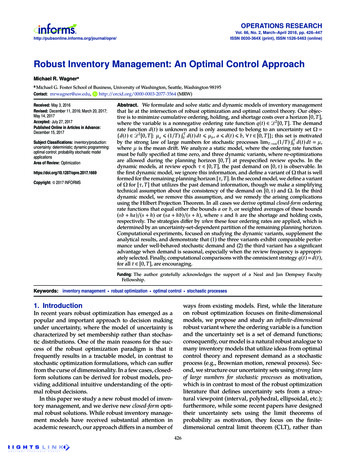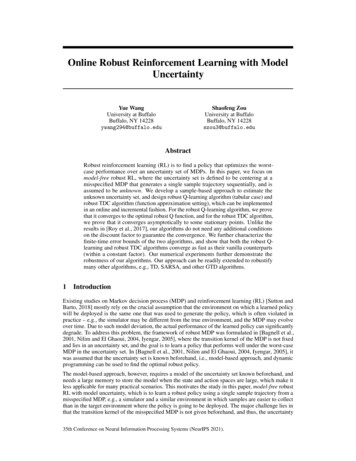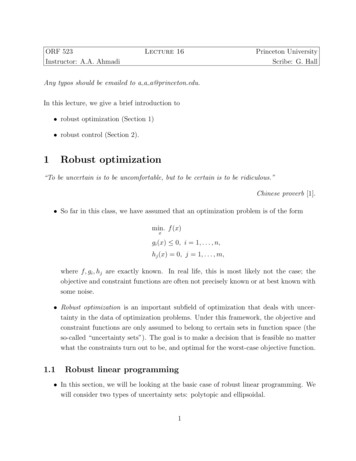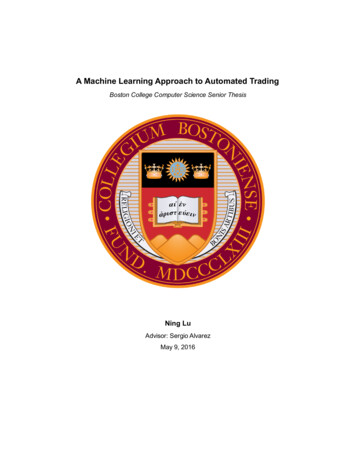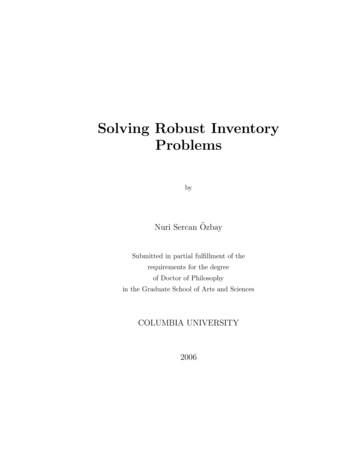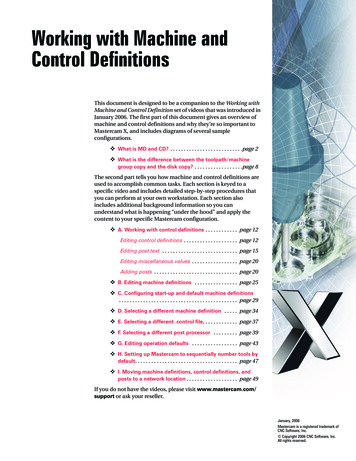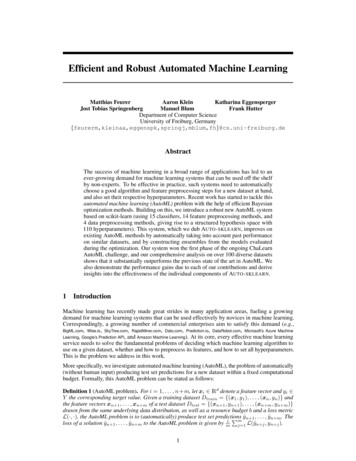
Transcription
Efficient and Robust Automated Machine LearningMatthias FeurerAaron KleinKatharina EggenspergerJost Tobias SpringenbergManuel BlumFrank HutterDepartment of Computer ScienceUniversity of Freiburg, @cs.uni-freiburg.deAbstractThe success of machine learning in a broad range of applications has led to anever-growing demand for machine learning systems that can be used off the shelfby non-experts. To be effective in practice, such systems need to automaticallychoose a good algorithm and feature preprocessing steps for a new dataset at hand,and also set their respective hyperparameters. Recent work has started to tackle thisautomated machine learning (AutoML) problem with the help of efficient Bayesianoptimization methods. Building on this, we introduce a robust new AutoML systembased on scikit-learn (using 15 classifiers, 14 feature preprocessing methods, and4 data preprocessing methods, giving rise to a structured hypothesis space with110 hyperparameters). This system, which we dub AUTO - SKLEARN, improves onexisting AutoML methods by automatically taking into account past performanceon similar datasets, and by constructing ensembles from the models evaluatedduring the optimization. Our system won the first phase of the ongoing ChaLearnAutoML challenge, and our comprehensive analysis on over 100 diverse datasetsshows that it substantially outperforms the previous state of the art in AutoML. Wealso demonstrate the performance gains due to each of our contributions and deriveinsights into the effectiveness of the individual components of AUTO - SKLEARN.1IntroductionMachine learning has recently made great strides in many application areas, fueling a growingdemand for machine learning systems that can be used effectively by novices in machine learning.Correspondingly, a growing number of commercial enterprises aim to satisfy this demand (e.g.,BigML.com, Wise.io, SkyTree.com, RapidMiner.com, Dato.com, Prediction.io, DataRobot.com, Microsoft’s Azure MachineLearning, Google’s Prediction API, and Amazon Machine Learning). At its core, every effective machine learningservice needs to solve the fundamental problems of deciding which machine learning algorithm touse on a given dataset, whether and how to preprocess its features, and how to set all hyperparameters.This is the problem we address in this work.More specifically, we investigate automated machine learning (AutoML), the problem of automatically(without human input) producing test set predictions for a new dataset within a fixed computationalbudget. Formally, this AutoML problem can be stated as follows:Definition 1 (AutoML problem). For i 1, . . . , n m, let xi Rd denote a feature vector and yi Y the corresponding target value. Given a training dataset Dtrain {(x1 , y1 ), . . . , (xn , yn )} andthe feature vectors xn 1 , . . . , xn m of a test dataset Dtest {(xn 1 , yn 1 ), . . . , (xn m , yn m )}drawn from the same underlying data distribution, as well as a resource budget b and a loss metricL(·, ·), the AutoML problem is to (automatically) produce test set predictionsPm ŷn 1 , . . . , ŷn m . The1loss of a solution ŷn 1 , . . . , ŷn m to the AutoML problem is given by mj 1 L(ŷn j , yn j ).1
In practice, the budget b would comprise computational resources, such as CPU and/or wallclock timeand memory usage. This problem definition reflects the setting of the ongoing ChaLearn AutoMLchallenge [1]. The AutoML system we describe here won the first phase of that challenge.Here, we follow and extend the AutoML approach first introduced by AUTO -WEKA [2] (seehttp://automl.org). At its core, this approach combines a highly parametric machine learningframework F with a Bayesian optimization [3] method for instantiating F well for a given dataset.The contribution of this paper is to extend this AutoML approach in various ways that considerablyimprove its efficiency and robustness, based on principles that apply to a wide range of machinelearning frameworks (such as those used by the machine learning service providers mentioned above).First, following successful previous work for low dimensional optimization problems [4, 5, 6],we reason across datasets to identify instantiations of machine learning frameworks that performwell on a new dataset and warmstart Bayesian optimization with them (Section 3.1). Second, weautomatically construct ensembles of the models considered by Bayesian optimization (Section 3.2).Third, we carefully design a highly parameterized machine learning framework from high-performingclassifiers and preprocessors implemented in the popular machine learning framework scikit-learn [7](Section 4). Finally, we perform an extensive empirical analysis using a diverse collection of datasetsto demonstrate that the resulting AUTO - SKLEARN system outperforms previous state-of-the-artAutoML methods (Section 5), to show that each of our contributions leads to substantial performanceimprovements (Section 6), and to gain insights into the performance of the individual classifiers andpreprocessors used in AUTO - SKLEARN (Section 7).2AutoML as a CASH problemWe first review the formalization of AutoML as a Combined Algorithm Selection and Hyperparameteroptimization (CASH) problem used by AUTO -WEKA’s AutoML approach. Two important problemsin AutoML are that (1) no single machine learning method performs best on all datasets and (2) somemachine learning methods (e.g., non-linear SVMs) crucially rely on hyperparameter optimization.The latter problem has been successfully attacked using Bayesian optimization [3], which nowadaysforms a core component of an AutoML system. The former problem is intertwined with the latter sincethe rankings of algorithms depend on whether their hyperparameters are tuned properly. Fortunately,the two problems can efficiently be tackled as a single, structured, joint optimization problem:Definition 2 (CASH). Let A {A(1) , . . . , A(R) } be a set of algorithms, and let the hyperparametersof each algorithm A(j) have domain Λ(j) . Further, let Dtrain {(x1 , y1 ), . . . , (xn , yn )} be a train(1)(K)(1)(K)ing set which is split into K cross-validation folds {Dvalid , . . . , Dvalid } and {Dtrain , . . . , Dtrain }(i)(i)(j)(i)(i)such that Dtrain Dtrain \Dvalid for i 1, . . . , K. Finally, let L(Aλ , Dtrain , Dvalid ) denote the(i)(i)loss that algorithm A(j) achieves on Dvalid when trained on Dtrain with hyperparameters λ. Then,the Combined Algorithm Selection and Hyperparameter optimization (CASH) problem is to find thejoint algorithm and hyperparameter setting that minimizes this loss:K1 X(j)(i)(i)A? , λ? argminL(Aλ , Dtrain , Dvalid ).(1)A(j) A,λ Λ(j) K i 1This CASH problem was first tackled by Thornton et al. [2] in the AUTO -WEKA system using themachine learning framework WEKA [8] and tree-based Bayesian optimization methods [9, 10]. Ina nutshell, Bayesian optimization [3] fits a probabilistic model to capture the relationship betweenhyperparameter settings and their measured performance; it then uses this model to select the mostpromising hyperparameter setting (trading off exploration of new parts of the space vs. exploitationin known good regions), evaluates that hyperparameter setting, updates the model with the result,and iterates. While Bayesian optimization based on Gaussian process models (e.g., Snoek et al. [11])performs best in low-dimensional problems with numerical hyperparameters, tree-based models havebeen shown to be more successful in high-dimensional, structured, and partly discrete problems [12] –such as the CASH problem – and are also used in the AutoML system H YPEROPT- SKLEARN [13].Among the tree-based Bayesian optimization methods, Thornton et al. [2] found the random-forestbased SMAC [9] to outperform the tree Parzen estimator TPE [10], and we therefore use SMACto solve the CASH problem in this paper. Next to its use of random forests [14], SMAC’s maindistinguishing feature is that it allows fast cross-validation by evaluating one fold at a time anddiscarding poorly-performing hyperparameter settings early.2
Bayesian optimizer{Xtrain , Ytrain ,Xtest , b, L}metalearningdata preprocessorfeatureclassifierpreprocessorML frameworkAutoMLsystembuildensembleŶtestFigure 1: Our improved AutoML approach. We add two components to Bayesian hyperparameter optimizationof an ML framework: meta-learning for initializing the Bayesian optimizer and automated ensemble constructionfrom configurations evaluated during optimization.3New methods for increasing efficiency and robustness of AutoMLWe now discuss our two improvements of the AutoML approach. First, we include a meta-learningstep to warmstart the Bayesian optimization procedure, which results in a considerable boost inefficiency. Second, we include an automated ensemble construction step, allowing us to use allclassifiers that were found by Bayesian optimization.Figure 1 summarizes the overall AutoML workflow, including both of our improvements. We notethat we expect their effectiveness to be greater for flexible ML frameworks that offer many degrees offreedom (e.g., many algorithms, hyperparameters, and preprocessing methods).3.1Meta-learning for finding good instantiations of machine learning frameworksDomain experts derive knowledge from previous tasks: They learn about the performance of machinelearning algorithms. The area of meta-learning [15] mimics this strategy by reasoning about theperformance of learning algorithms across datasets. In this work, we apply meta-learning to selectinstantiations of our given machine learning framework that are likely to perform well on a newdataset. More specifically, for a large number of datasets, we collect both performance data and a setof meta-features, i.e., characteristics of the dataset that can be computed efficiently and that help todetermine which algorithm to use on a new dataset.This meta-learning approach is complementary to Bayesian optimization for optimizing an MLframework. Meta-learning can quickly suggest some instantiations of the ML framework that arelikely to perform quite well, but it is unable to provide fine-grained information on performance.In contrast, Bayesian optimization is slow to start for hyperparameter spaces as large as those ofentire ML frameworks, but can fine-tune performance over time. We exploit this complementarity byselecting k configurations based on meta-learning and use their result to seed Bayesian optimization.This approach of warmstarting optimization by meta-learning has already been successfully appliedbefore [4, 5, 6], but never to an optimization problem as complex as that of searching the spaceof instantiations of a full-fledged ML framework. Likewise, learning across datasets has alsobeen applied in collaborative Bayesian optimization methods [16, 17]; while these approaches arepromising, they are so far limited to very few meta-features and cannot yet cope with the highdimensional partially discrete configuration spaces faced in AutoML.More precisely, our meta-learning approach works as follows. In an offline phase, for each machinelearning dataset in a dataset repository (in our case 140 datasets from the OpenML [18] repository),we evaluated a set of meta-features (described below) and used Bayesian optimization to determineand store an instantiation of the given ML framework with strong empirical performance for thatdataset. (In detail, we ran SMAC [9] for 24 hours with 10-fold cross-validation on two thirds of thedata and stored the resulting ML framework instantiation which exhibited best performance on theremaining third). Then, given a new dataset D, we compute its meta-features, rank all datasets bytheir L1 distance to D in meta-feature space and select the stored ML framework instantiations forthe k 25 nearest datasets for evaluation before starting Bayesian optimization with their results.To characterize datasets, we implemented a total of 38 meta-features from the literature, includingsimple, information-theoretic and statistical meta-features [19, 20], such as statistics about the numberof data points, features, and classes, as well as data skewness, and the entropy of the targets. Allmeta-features are listed in Table 1 of the supplementary material. Notably, we had to exclude theprominent and effective category of landmarking meta-features [21] (which measure the performanceof simple base learners), because they were computationally too expensive to be helpful in the onlineevaluation phase. We note that this meta-learning approach draws its power from the availability of3
a repository of datasets; due to recent initiatives, such as OpenML [18], we expect the number ofavailable datasets to grow ever larger over time, increasing the importance of meta-learning.3.2Automated ensemble construction of models evaluated during optimizationWhile Bayesian hyperparameter optimization is data-efficient in finding the best-performing hyperparameter setting, we note that it is a very wasteful procedure when the goal is simply to make goodpredictions: all the models it trains during the course of the search are lost, usually including somethat perform almost as well as the best. Rather than discarding these models, we propose to store themand to use an efficient post-processing method (which can be run in a second process on-the-fly) toconstruct an ensemble out of them. This automatic ensemble construction avoids to commit itself to asingle hyperparameter setting and is thus more robust (and less prone to overfitting) than using thepoint estimate that standard hyperparameter optimization yields. To our best knowledge, we are thefirst to make this simple observation, which can be applied to improve any Bayesian hyperparameteroptimization method.It is well known that ensembles often outperform individual models [22, 23], and that effectiveensembles can be created from a library of models [24, 25]. Ensembles perform particularly well ifthe models they are based on (1) are individually strong and (2) make uncorrelated errors [14]. Sincethis is much more likely when the individual models are different in nature, ensemble building isparticularly well suited for combining strong instantiations of a flexible ML framework.However, simply building a uniformly weighted ensemble of the models found by Bayesian optimization does not work well. Rather, we found it crucial to adjust these weights using the predictions ofall individual models on a hold-out set. We experimented with different approaches to optimize theseweights: stacking [26], gradient-free numerical optimization, and the method ensemble selection [24].While we found both numerical optimization and stacking to overfit to the validation set and to becomputationally costly, ensemble selection was fast and robust. In a nutshell, ensemble selection(introduced by Caruana et al. [24]) is a greedy procedure that starts from an empty ensemble and theniteratively adds the model that maximizes ensemble validation performance (with uniform weight,but allowing for repetitions). Procedure 1 in the supplementary material describes it in detail. Weused this technique in all our experiments – building an ensemble of size 50.4A practical automated machine learning systemTo design a robust AutoML system, asfeatureestimatorpreprocessingclassifierour underlying ML framework we chosepreprocessorscikit-learn [7], one of the best known· · · AdaBoostRFkNNPCANone · · · fast ICAand most widely used machine ies. It offers a wide range of well espreprocessortablished and efficiently-implemented MLimputation balancingrescalingone hot enc.algorithms and is easy to use for both experts and beginners. Since our AutoMLmean · · · median···weightingmin/max · · · standardNonesystem closely resembles AUTO -WEKA,but – like H YPEROPT- SKLEARN – is based Figure 2: Structured configuration space. Squared boxeson scikit-learn, we dub it AUTO - SKLEARN. denote parent hyperparameters whereas boxes with roundedFigure 2 depicts AUTO - SKLEARN’s overall edges are leaf hyperparameters. Grey colored boxes markcomponents. It comprises 15 classification active hyperparameters which form an example configurationand machine learning pipeline. Each pipeline comprises onealgorithms, 14 preprocessing methods, and feature preprocessor, classifier and up to three data prepro4 data preprocessing methods. We param- cessor methods plus respective hyperparameters.eterized each of them, which resulted in aspace of 110 hyperparameters. Most of these are conditional hyperparameters that are only activeif their respective component is selected. We note that SMAC [9] can handle this conditionalitynatively.All 15 classification algorithms in AUTO - SKLEARN are listed in Table 1a (and described in detail inSection A.1 of the supplementary material). They fall into different categories, such as general linearmodels (2 algorithms), support vector machines (2), discriminant analysis (2), nearest neighbors(1), naı̈ve Bayes (3), decision trees (1) and ensembles (4). In contrast to AUTO -WEKA [2], we4
namename#λcat (cond)cont (cond)AdaBoost (AB)Bernoulli naı̈ve Bayesdecision tree (DT)extreml. rand. treesGaussian naı̈ve Bayesgradient boosting (GB)kNNLDAlinear SVMkernel SVMmultinomial naı̈ve Bayespassive aggressiveQDArandom forest (RF)Linear Class. (SGD)4245634472325101 (-)1 (-)1 (-)2 (-)2 (-)1 (-)2 (-)2 (-)1 (-)1 (-)2 (-)4 (-)3 (-)1 (-)3 (-)3 (-)6 (-)1 (-)3 (1)2 (-)5 (2)1 (-)2 (-)2 (-)3 (-)6 (3)(a) classification algorithms#λcat (cond)cont (cond)extreml. rand. trees prepr.fast ICAfeature agglomerationkernel PCArand. kitchen sinkslinear SVM prepr.no preprocessingnystroem samplerPCApolynomialrandom trees embed.select percentileselect rates5445235234232 (-)3 (-)3 ()1 (-)1 (-)1 (-)1 (-)2 (-)1 (-)2 (-)3 (-)1 (1)1 (-)4 (3)2 (-)2 (-)4 (3)1 (-)1 (-)4 (-)1 (-)1 (-)one-hot encodingimputationbalancingrescaling21111 (-)1 (-)1 (-)1 (-)1 (1)-(b) preprocessing methodsTable 1: Number of hyperparameters for each possible classifier (left) and feature preprocessing method(right) for a binary classification dataset in dense representation. Tables for sparse binary classification andsparse/dense multiclass classification datasets can be found in the Section E of the supplementary material,Tables 2a, 3a, 4a, 2b, 3b and 4b. We distinguish between categorical (cat) hyperparameters with discrete valuesand continuous (cont) numerical hyperparameters. Numbers in brackets are conditional hyperparameters, whichare only relevant when another parameter has a certain value.focused our configuration space on base classifiers and excluded meta-models and ensembles thatare themselves parameterized by one or more base classifiers. While such ensembles increasedAUTO -WEKA’s number of hyperparameters by almost a factor of five (to 786), AUTO - SKLEARN“only” features 110 hyperparameters. We instead construct complex ensembles using our post-hocmethod from Section 3.2. Compared to AUTO -WEKA, this is much more data-efficient: in AUTO WEKA, evaluating the performance of an ensemble with 5 components requires the construction andevaluation of 5 models; in contrast, in AUTO - SKLEARN, ensembles come largely for free, and it ispossible to mix and match models evaluated at arbitrary times during the optimization.The preprocessing methods for datasets in dense representation in AUTO - SKLEARN are listed inTable 1b (and described in detail in Section A.2 of the supplementary material). They comprise datapreprocessors (which change the feature values and are always used when they apply) and featurepreprocessors (which change the actual set of features, and only one of which [or none] is used). Datapreprocessing includes rescaling of the inputs, imputation of missing values, one-hot encoding andbalancing of the target classes. The 14 possible feature preprocessing methods can be categorized intofeature selection (2), kernel approximation (2), matrix decomposition (3), embeddings (1), featureclustering (1), polynomial feature expansion (1) and methods that use a classifier for feature selection(2). For example, L1 -regularized linear SVMs fitted to the data can be used for feature selection byeliminating features corresponding to zero-valued model coefficients.As with every robust real-world system, we had to handle many more important details in AUTO SKLEARN ; we describe these in Section B of the supplementary material.5Comparing AUTO - SKLEARN to AUTO -WEKA and H YPEROPT- SKLEARNAs a baseline experiment, we compared the performance of vanilla AUTO - SKLEARN (without ourimprovements) to AUTO -WEKA and H YPEROPT- SKLEARN, reproducing the experimental setupwith 21 datasets of the paper introducing AUTO -WEKA [2]. We describe this setup in detail inSection G in the supplementary material.Table 2 shows that AUTO - SKLEARN performed statistically significantly better than AUTO -WEKAin 6/21 cases, tied it in 12 cases, and lost against it in 3. For the three datasets where AUTO WEKA performed best, we found that in more than 50% of its runs the best classifier it chose is notimplemented in scikit-learn (trees with a pruning component). So far, H YPEROPT- SKLEARN is moreof a proof-of-concept – inviting the user to adapt the configuration space to her own needs – thana full AutoML system. The current version crashes when presented with sparse data and missingvalues. It also crashes on Cifar-10 due to a memory limit which we set for all optimizers to enable a5
0.010.010.0514.93 33.76 40.6714.13 33.36 37.7514.07 34.72 .92 7.8760.34 8.0955.79 -Semeion12.44 2.8418.21 2.8414.74 cKR-vs-KP27.00 1.6228.33 2.2927.67 erConvexCifar-10Small51.70 54.81 17.53 5.5656.95 56.20 21.80 8.3357.95 19.18 -Dorothea73.50 16.00 0.3973.50 30.00 0.0076.21 16.22 0.39Cifar-10CarAmazonAbaloneASAWHSTable 2: Test set classification error of AUTO -WEKA (AW), vanilla AUTO - SKLEARN (AS) and H YPEROPTSKLEARN (HS), as in the original evaluation of AUTO -WEKA [2]. We show median percent error across100 000 bootstrap samples (based on 10 runs), simulating 4 parallel runs. Bold numbers indicate the best result.Underlined results are not statistically significantly different from the best according to a bootstrap test withp 0.05.3.0average rank2.82.62.4vanilla auto-sklearnauto-sklearn ensembleauto-sklearn meta-learningauto-sklearn meta-learning ensemble2.22.01.8500100015002000time [sec]250030003500Figure 3: Average rank of all four AUTO - SKLEARN variants (ranked by balanced test error rate (BER)) across140 datasets. Note that ranks are a relative measure of performance (here, the rank of all methods has to add upto 10), and hence an improvement in BER of one method can worsen the rank of another. The supplementarymaterial shows the same plot on a log-scale to show the time overhead of meta-feature and ensemble computation.fair comparison. On the 16 datasets on which it ran, it statistically tied the best optimizer in 9 casesand lost against it in 7.6Evaluation of the proposed AutoML improvementsIn order to evaluate the robustness and general applicability of our proposed AutoML system ona broad range of datasets, we gathered 140 binary and multiclass classification datasets from theOpenML repository [18], only selecting datasets with at least 1000 data points to allow robustperformance evaluations. These datasets cover a diverse range of applications, such as text classification, digit and letter recognition, gene sequence and RNA classification, advertisement, particleclassification for telescope data, and cancer detection in tissue samples. We list all datasets in Table 7and 8 in the supplementary material and provide their unique OpenML identifiers for reproducibility.Since the class distribution in many of these datasets is quite imbalanced we evaluated all AutoMLmethods using a measure called balanced classification error rate (BER). We define balanced errorrate as the average of the proportion of wrong classifications in each class. In comparison to standardclassification error (the average overall error), this measure (the average of the class-wise error)assigns equal weight to all classes. We note that balanced error or accuracy measures are often usedin machine learning competitions (e.g., the AutoML challenge [1] uses balanced accuracy).We performed 10 runs of AUTO - SKLEARN both with and without meta-learning and with and withoutensemble prediction on each of the datasets. To study their performance under rigid time constraints,and also due to computational resource constraints, we limited the CPU time for each run to 1 hour; wealso limited the runtime for a single model to a tenth of this (6 minutes). To not evaluate performanceon data sets already used for meta-learning, we performed a leave-one-dataset-out validation: whenevaluating on dataset D, we only used meta-information from the 139 other datasets.Figure 3 shows the average ranks over time of the four AUTO - SKLEARN versions we tested. Weobserve that both of our new methods yielded substantial improvements over vanilla AUTO - SKLEARN.The most striking result is that meta-learning yielded drastic improvements starting with the first6
OpenMLdataset IDAUTO-SKLEARNAdaBoostBernoullinaı̈ve Bayesdecisiontreeextreml.rand. treesGaussiannaı̈ve BayesgradientboostingkNNLDAlinear SVMkernel SVMmultinomialnaı̈ve BayespassiveaggresiveQDArandom forestLinear 4.664.3315.5417.99Table 3: Median balanced test error rate (BER) of optimizing AUTO - SKLEARN subspaces for each classificationOpenMLdataset IDAUTO-SKLEARNdensifierextreml. rand.trees prepr.fast ICAfeatureagglomerationkernel PCArand.kitchen sinkslinearSVM trees embed.select percentileclassificationselect ratestruncatedSVDmethod (and all preprocessors), as well as the whole configuration space of AUTO - SKLEARN, on 13 datasets.All optimization runs were allowed to run for 24 hours except for AUTO - SKLEARN which ran for 48 hours.Bold numbers indicate the best result; underlined results are not statistically significantly different from the bestaccording to a bootstrap test using the same setup as for Table 3313.674.082.7419.184.0521.58Table 4: Like Table 3, but instead optimizing subspaces for each preprocessing method (and all classifiers).configuration it selected and lasting until the end of the experiment. We note that the improvementwas most pronounced in the beginning and that over time, vanilla AUTO - SKLEARN also found goodsolutions without meta-learning, letting it catch up on some datasets (thus improving its overall rank).Moreover, both of our methods complement each other: our automated ensemble constructionimproved both vanilla AUTO - SKLEARN and AUTO - SKLEARN with meta-learning. Interestingly, theensemble’s influence on the performance started earlier for the meta-learning version. We believethat this is because meta-learning produces better machine learning models earlier, which can bedirectly combined into a strong ensemble; but when run longer, vanilla AUTO - SKLEARN withoutmeta-learning also benefits from automated ensemble construction.7Detailed analysis of AUTO - SKLEARN componentsWe now study AUTO - SKLEARN’s individual classifiers and preprocessors, compared to jointlyoptimizing all methods, in order to obtain insights into their peak performance and robustness. Ideally,we would have liked to study all combinations of a single classifier and a single preprocessor inisolation, but with 15 classifiers and 14 preprocessors this was infeasible; rather, when studying theperformance of a single classifier, we still optimized over all preprocessors, and vice versa. To obtaina more detailed analysis, we focused on a subset of datasets but extended the configuration budget foroptimizing all methods from one hour to one day and to two days for AUTO - SKLEARN. Specifically,we clustered our 140 datasets with g-means [27] based on
Building on this, we introduce a robust new AutoML system based on scikit-learn (using 15 classifiers, 14 feature preprocessing methods, and . demand for machine learning systems that can be used effectively by novices in machine learning. Correspondingly, a growing number of commercial enterprises aim to satisfy this demand (e.g., .
